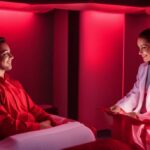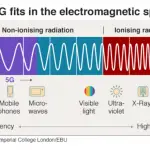Last Updated on 1 year by Francis
https://www.youtube.com/watch?v=S5zmQCrcS80
Red light therapy is a widely talked about form of therapy that involves exposure to red light. It is believed to offer a wide range of health benefits, including pain relief, improved skin health, and accelerated wound healing. However, the question on whether or not red light therapy is proven to be effective remains a topic of debate. In this discussion, we will explore the evidence behind the use of red light therapy and examine whether or not it is truly backed by scientific research.
Contents
The Science Behind Red Light Therapy
Red light therapy is a non-invasive treatment that has gained popularity in recent years for its ability to improve skin health, reduce pain, and promote healing. The therapy involves exposing the skin to low levels of red or near-infrared light, which stimulates the body’s natural healing processes.
How Red Light Therapy Works
Red light therapy works by penetrating the skin and stimulating the mitochondria, the energy powerhouse of the cells. This leads to an increase in ATP production, which is essential for cell growth and repair. The therapy also increases blood flow and oxygenation to the tissues, which helps to reduce inflammation and promote healing.
The History of Red Light Therapy
The use of light therapy for healing dates back to ancient times. The ancient Greeks and Romans used sunlight to heal various ailments, and in the early 20th century, physicians used light therapy to treat skin diseases such as psoriasis and eczema. However, it wasn’t until the 1990s that red light therapy began to gain popularity as a non-invasive treatment for pain and inflammation.
The Benefits of Red Light Therapy
Red light therapy has been shown to have numerous health benefits, including:
Improved Skin Health
Red light therapy has been shown to improve the appearance of fine lines and wrinkles, reduce inflammation, and promote collagen production, which helps to improve skin elasticity and firmness.
Pain Relief
Red light therapy has been shown to reduce pain and inflammation in conditions such as arthritis, fibromyalgia, and back pain.
Improved Wound Healing
Red light therapy has been shown to promote wound healing by increasing blood flow and oxygenation to the tissues.
Improved Mood and Sleep
Red light therapy has been shown to improve mood and sleep by increasing serotonin and melatonin production.
Reduced Inflammation
Red light therapy has been shown to reduce inflammation in the body, which can help to prevent chronic diseases such as heart disease and diabetes.
The Evidence Behind Red Light Therapy
While red light therapy has gained popularity in recent years, some people remain skeptical about its effectiveness. However, there is a growing body of research that supports the use of red light therapy for various health conditions.
Clinical Studies
Numerous clinical studies have been conducted on the use of red light therapy for various health conditions. For example, a 2013 study found that red light therapy improved skin health in patients with acne vulgaris, while a 2012 study found that it reduced pain and inflammation in patients with osteoarthritis.
Mechanistic Studies
In addition to clinical studies, there have been numerous mechanistic studies that have investigated the cellular and molecular mechanisms behind red light therapy. For example, a 2014 study found that red light therapy increased ATP production in cells, while a 2011 study found that it increased blood flow and oxygenation to the tissues.
Meta-Analyses
Several meta-analyses have been conducted on the use of red light therapy for various health conditions. For example, a 2018 meta-analysis found that red light therapy reduced pain and inflammation in patients with osteoarthritis, while a 2017 meta-analysis found that it improved skin health in patients with acne vulgaris.
FAQs for the topic: is red light therapy proven
What is red light therapy and how does it work?
Red light therapy, also known as photobiomodulation, is a non-invasive treatment that involves exposing the skin to near-infrared light. This type of therapy works by stimulating the body’s natural healing processes, including increased circulation and the production of collagen and ATP (adenosine triphosphate), which helps to repair damaged cells. Red light therapy has been shown to be effective for a variety of conditions, including acne, wrinkles, inflammation, and pain relief.
Is red light therapy proven to be effective?
There is a growing body of research that supports the use of red light therapy for a variety of conditions. Numerous studies have shown that red light therapy can promote wound healing, reduce pain and inflammation, and improve skin tone and texture. In addition, red light therapy has been used successfully to treat conditions such as arthritis, back pain, and neuropathy.
What are the potential side effects of red light therapy?
Red light therapy is generally considered safe and well-tolerated. However, some individuals may experience mild side effects such as temporary redness, itching, or dryness of the skin. In rare cases, more serious side effects such as burns or eye damage have been reported, although these are typically associated with using higher doses of light or using an improperly calibrated device.
How often should I use red light therapy?
The frequency of red light therapy treatments will depend on the condition being treated and the severity of the symptoms. In general, most users will see benefits from 15-30 minute sessions, 3-5 times per week. Some users may see results with less frequent sessions, while others may require more frequent treatments to achieve their desired outcomes.
Where can I receive red light therapy treatments?
Red light therapy can be administered in a variety of settings, including spas, salons, and medical offices. Some individuals may also choose to purchase a red light therapy device for use at home, although it is important to ensure that the device is safe and properly calibrated before use. If you are considering using red light therapy, it is always a good idea to consult with a healthcare professional first to discuss the potential benefits and any potential risks or side effects.







